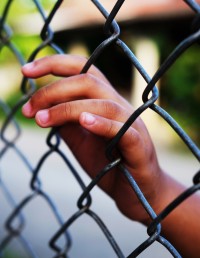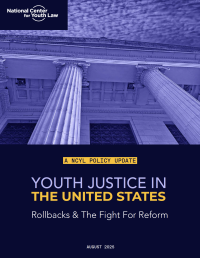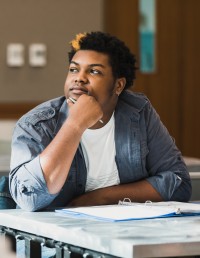Locked Away Forever
The Case Against Life Without Parole
By Pat Arthur and Brittany Star Armstrong
There are more than 2,000 child offenders serving life without parole (LWOP) sentences in United States prisons for crimes committed before the age of 18.
1 The United States is one of only a few countries in the world that permits children who commit crimes to be sentenced to prison forever, without any possibility of release.2 Only eight states in this country – Alaska, Colorado, Kansas, Kentucky, Maine, New Mexico, New York, and West Virginia – and the District of Columbia prohibit life without parole for youthful offenders.
Unfortunately, adolescents,like adults, commit horrible crimes and make terrible mistakes. And, like adults, they should be held accountable – but in accordance with their age, stage of development, and greater capacity for rehabilitation. A sentence of life in prison is excessively harsh for such young people, many of whom were themselves victims of abuse or neglect.
An estimated 26 percent of juveniles sentenced to prison for life were convicted of a felony murder, that is, for participating in a robbery or burglary during which a co-participant committed murder, in some cases without the knowledge of the teen.3 Fifty-nine percent of youth sentenced to LWOP are serving time for a first-time offense.4 In 26 states, the sentence of life without parole is mandatory for anyone, even a juvenile, who is found guilty of committing first degree murder.
The disproportionate use of this sentence on youth of color is extreme. Nationwide, black youth are sentenced to LWOP at a rate 10 times greater than white youth.5 In California, 158 of the 180 people serving LWOP for crimes committed before the age of 18 are youth of color.6 Black youth in California are 22.5 times more likely to receive a life without parole sentence than white youth.7
Juveniles sentenced to LWOP frequently receive ineffective assistance of counsel during pre-trial and plea proceedings, and at trial and sentencing.8 For example, a federal district court judge in Washington state found that Donald Lambert, who at the age of 16 plead guilty to aggravated first degree murder and received a mandatory life sentence, was not provided constitutionally adequate representation.9 Nevertheless, Lambert is serving life without parole at the Walla Wall State Penitentiary in Washington state. The Ninth Circuit Court of Appeals rejected on technical grounds the grant of habeas corpus relief by the district court.10
A juvenile sentenced to LWOP in Michigan in 1989 for felony murder describes his representation this way:
I did not see my attorney at all. I called his office and no one accepted the calls. He never visitedme. I never had any kind of interview about the crime, I never even talked to him about the crimes. I seen him one time at a hearing that lasted about 5 minutes, then I seen him twice IN THE COURT ROOM at trial that was a two day trial and then I seen him moments before I was to be sentenced. When I seen him before the sentence it was in the bullpen behind the courtroom and he told me there that Id be getting natural life. I kept asking him when I’d be going home, but another inmate explained it all to me. He never asked me if I even did the crime. I didn’t know anything about the law or that he was supposed to comand see me during the trial. I went through a murder trial at the age of 15 with out ever talking to my attorney.11
In other legal contexts, youth are not treated as having the same capacity as adults. For example, they are not considered responsible enough to enter into contracts, to vote, to marry, or to leave school. Yet, in most states, they are presumed as fully responsible as an adult for purposes of the criminal process – they can plead guilty, go through complicated legal proceedings, and be sent to prison to die – without regard to their age and diminished capacity.
A Growing Campaign to Stop Sentencing Juveniles to Life Without Parole
In light of the recent recognition by the U.S. Supreme Court that juveniles should not be held to the same standard of criminal culpability as adults,12 the elimination of juvenile life without parole sentences is becoming an increasingly important subject of juvenile justice reform.13 Children’s advocates, faith-based groups, human rights advocates, juvenile justice experts, families of juveniles serving LWOP sentences, and even the victims of serious crimes have joined together in voicing their disagreement with the use of LWOP to punish youth who “are not yet the persons they will become.”14 The advocacy is supported by growing public opposition to the use of LWOP on juveniles. A poll conducted of Americans on the West Coast found that 86 percent disagree with the idea that children who commit crimes are so beyond redemption that they should be locked up for the rest of their lives without any opportunity to ever earn their release.15
Litigation and legislative efforts to eliminate juvenile LWOP sentences are underway and in various stages of planning in several states, including Michigan, Illinois, Pennsylvania, Louisiana, California and Washington state. The Colorado Legislature just recently enacted a law that eliminates the future use of LWOP sentences on juveniles.16 In Mississippi and Washington, the NAACP Legal Defense & Educational Fund, Inc. is focusing advocacy and research efforts on the racial disparities in LWOP sentencing. The Juvenile Justice Committee of the Criminal Justice Section of the American Bar Association is working on a proposed Bar Resolution regarding juvenile LWOP.
The media are paying greater attention to this unfair sentencing practice. Media coverage is providing more complete portraits of the juveniles who have been sent to prison for life.17
Internationally, many are working to call attention to the use of LWOP sentences to punish juveniles in the United States, a practice that violates the Convention on the Rights of the Child, the International Bill of Rights, and the International Covenant on Civil and Political Rights. The sentencing of youth to life without parole was included in a juvenile justice resolution adopted by the Human Rights Commission in Geneva in 2005. Human Rights Watch has made submissions calling for the elimination life without parole sentences for juveniles to the Committee against Torture, the Human Rights Committee, and to the UN Secretary-General’s Study on Violence against Children. A petition has been submitted on behalf of child offenders sentenced to life without parole to the United States Inter-American Court on Human Rights showing how this cruel sentencing practice of violates principles of international law.18
All involved in the campaign to stop the sentencing of children to die in prison are deeply motivated by the life stories of these truly discarded children and believe deeply in their capacity for rehabilitation.
Pat Arthur is a senior attorney at NCYL, specializing in juvenile justice reform. Brittany Starr Armstrong interned at NCYL in summer 2006 as an Arthur Liman Public Interest Fellow. She is in her first year of law school at University of San Francisco Law School.
Footnotes:
1 The Rest of Their Lives: Life without Parole for Child Offenders in the United States, Human Rights Watch and Amnesty International, October, 2005, p.1, available at: hrw.org/reports/2005/us1005/
2 Id. at 5.
3 Id. at 27.
4 Id. at 28.
5 Id. at 2.
6 National Center for Youth Law interview with Alison Parker (Human Rights Watch author of The Rest of Their Lives), March 2, 2006.
7 The Rest of Their Lives, at 40.
8 See e.g. Miles Moffeit and Kevin Simpson, Judges in Both Cases Troubled by End Results, Denver Post, Feb. 21, 2006; Ken Armstrong, Florangela Davila, Justin Mayo, “For Some, Free Counsel Comes at High Cost, Seattle Times, April 4, 2004, available at: seattletimes.nwsource.com/news/local/unequaldefense/
stories/one/
9 Lambert v. Blodgett, 248 F.Supp. 2d 988 (E.D. Wash. 2003), aff’d in part, rev’d in part, 393 F. 3d 943 (9th Cir. 2004), cert.denied, 126 S. Ct. 484 (2005).
10 Lambert v. Blodgett, 393 F.3rd 943 (9th C ir.2004)
11 Second Chances: Juveniles Serving Life without Parole in Michigan Prisons (ACLU of Michigan, 2004), p. 16, available at: www.aclumich.org/pubs/juvenilelifers.pdf.
12 Roper v. Simmons, 543 U.S. 551 (2005) (juvenile death penalty violates the Eighth Amendment’s prohibition against cruel and unusual punishment).
13 Relying on neuroscience and psychological research, the Court in Roper found that youth tend to make “impetuous and ill-considered decisions,” they have “susceptibility to negative influences and outside pressures,” and the nature of their character traits is “transitory,” making their capacity for rehabilitation greater than that of adults. Id. at 569-570.
14 Naovarath v. State, 779 P.2d 944, 944 (Nev. 1989), cited in Nina Chernoff and Marsha Levick, “Beyond the Death Penalty: Implications of Adolescent Development Research for the Prosecution, Defense, and Sanctioning of Youthful Offenders, Clearinghouse REVIEW Journal of Poverty Law and Policy, July-August 2005, at.212.
15 National Center for Youth Law interview with Alison Parker (Human Rights Watch author of The Rest of Their Lives), March 2, 2006.
16 206 Colo. Legis. Ch. 228 (West).
17 For example, the Denver Post ran an in-depth series highlighting the extreme physical, emotional, and sexual abuse suffered during childhood of many juveniles serving LWOP sentences. Miles Moffeit and Kevin Simpson, “Teen Crime, Adult Time,” Denver Post, Feb. 17, 2006, available at: www.denverpost.com/teencrime. See also: www/denverpost.com/portlet/article/html/fragments/
print_article.jsp?article=3636564.
18 Petition is available from National Center for Youth Law.
National Coalition to Ban Life Without Parole for Youth Offenders
National Center for Youth Law (NCYL) Senior Attorney Pat Arthur is working with Human Rights Watch, private law firms, and a number of other organizations to end the practice of sentencing child offenders to life without parole.
As part of this initiative, NCYL and other advocacy organizations are working to eliminate life without the possibility of parole as a sentencing option in California and Washington state for youth who commit a crime while under the age of 18.
NCYL is also part of an effort to create a national coalition for coordinating advocacy to ban this sentencing around the country. The advocates in this coalition take heart in the U.S. Supreme Court’s decision in Roper v. Simmons, 543 U.S. 551 (2005) because it acknowledges fundamental differences between adults and children that make egregiously harsh sentencing disproportionate and unnecessary.
Children Behind Bars for Life
Roy Ayala was sentenced in California to serve life without the possibility of parole for a murder committed during the course of a robbery. He is Latino and was 17 at the time of the crime. He was then homeless and addicted to morphine. His dad beat him—sometimes to the point of unconsciousness. He had left home at 13 and “lived mostly on the streets.” As he puts it, “I was “searching for direction in the wrong crowd.” Now, at 26, he is “praying for a second chance to live my life back in society someday.”1 He has attempted suicide in the past. In prison, he writes poetry and reads a lot, but is otherwise idle all day. He receives no education or programming. He recently wrote the poem, featured on the facing page, about his life.
Sara Kruzan grew up in Riverside, California. She is bi-racial. She was raised by her mother, a Caucasian, who was addicted to drugs and abusive to Sara. Sara was placed in foster care as a teen. Sara has met her African-American father only three times in her life because he has been in prison serving time for serious felony convictions.
Since the age of 9, Sara has suffered from severe depression for which she has been hospitalized several times. She has attempted suicide on multiple occasions.
At age 11, Sara met a 31-year-old man named “G.G.” Soon after they met, G.G. molested Sara, and soon began grooming her to become a prostitute. At age 13, Sara began working as a prostitute for G.G. Sara had just turned 16 when she was convicted of killing G.G. Sara had never before been arrested. Sara says a friend of her then-boyfriend who was much older and a rival of G.G. was involved in the murder but never prosecuted. Sara was tried as an adult, and sentenced to the rest of her life in prison, even though the California Youth Authority (CYA) determined that she was “amenable to the training and treatment” they offered.2 In its evaluation of Sara,the CYA concluded:
[Sara] appears to be motivated to make positive changes in her life and has expressed a desire to participate in Youth Authority programming rather than be sent to state prison. With respect to the referring offense [the killing of G.G.], it is recognized that the crime was particularly callous and premeditated. However, it is noted that her male co-offender was considerably older than Sara and she was strongly vulnerable to exploitation by him. The psychiatric evaluation submitted by Dr. Sneed concludes that she is treatable.
Sara is now 28. As she says, “The way I think now is very different than the way I thought then.”3 In prison, Sara does whatever she can to keep up her hope. “I survive in here spiritually. I can’t give up.I read. I do whatever I can to be a better person.”4
1 National Center for Youth Law interview of Roy Ayala, at Folsom Prison, Repressa, California, January 25, 2006.
2 Petition for Writ of Habeas Corpus, filed on September 12, 2005, in the California Supreme Court Case No. S137142 (Exhibit 2).
3 National Center for Youth interview of Sara Kruzan, Central California Women’s Facility, Chowchilla California, January 25, 2006.
4 Id.





